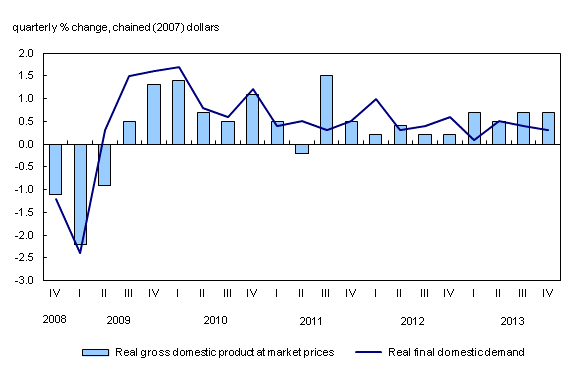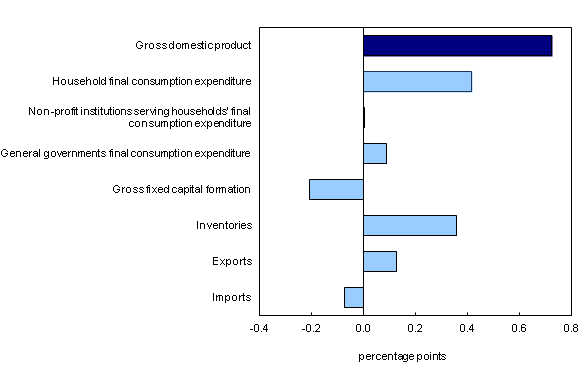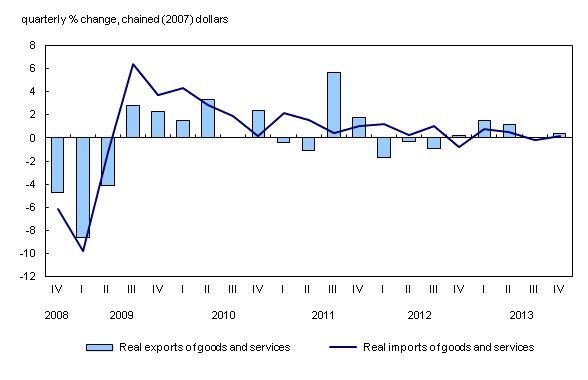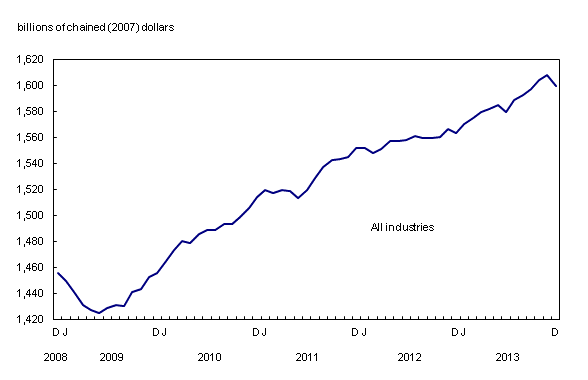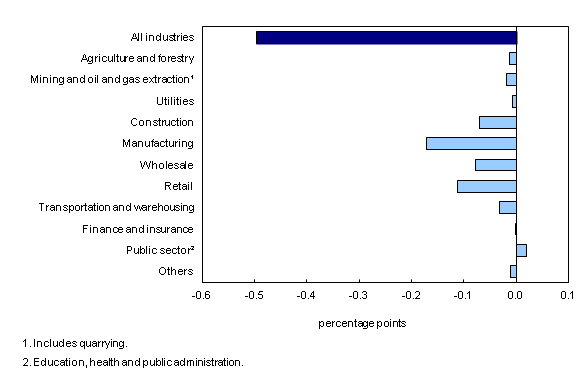Canadian economic accounts, fourth quarter 2013 and December 2013
Archived Content
Information identified as archived is provided for reference, research or recordkeeping purposes. It is not subject to the Government of Canada Web Standards and has not been altered or updated since it was archived. Please "contact us" to request a format other than those available.
Released: 2014-02-28
Real gross domestic product (GDP) expanded 0.7% in the fourth quarter, the same increase as in the third quarter. On a monthly basis, real GDP fell 0.5% in December.
Final domestic demand rose 0.3% in the fourth quarter, as household and government final consumption expenditure increased while business gross fixed capital formation declined. This was the second consecutive quarter that final domestic demand grew at a slower pace than real GDP.
Household final consumption expenditure advanced 0.8%, led by increased spending on services and non-durable goods. Outlays on semi-durable goods were also higher.
Business gross fixed capital formation declined 0.5% in the fourth quarter after increasing 0.3% in the third quarter. Business investment in residential and non-residential structures were both lower, while outlays on machinery and equipment were higher.
Business investment in inventories was $18.1 billion in the fourth quarter, up from $12.4 billion in the third quarter. Non-farm inventories accounted for most of the added stock.
Exports rose 0.4% in the fourth quarter, after a flat third quarter. Imports increased 0.2% after declining the previous quarter.
Most major industrial sectors increased production in the fourth quarter. The output of service industries and goods-producing industries both increased 0.7%.
Mining and oil and gas extraction grew 1.8% in the fourth quarter. Manufacturing was up 0.8%, following two quarters of essentially no growth. Transportation and warehousing services posted a notable increase. The public sector, the finance and insurance sector, retail and wholesale trade also increased. Conversely, construction as well as the agriculture and forestry sector declined.
Expressed at an annualized rate, real GDP expanded 2.9% in the fourth quarter. By comparison, real GDP in the United States grew 3.2%.
Household spending grows at slightly faster pace
Household final consumption expenditure increased 0.8% in the fourth quarter, up from 0.6% in the previous quarter. Outlays on goods rose 0.9% as a result of increased spending on semi-durable (+1.5%) and non-durable goods (+1.4%), while spending on services grew 0.6%.
Outlays on electricity, gas and other fuels (+5.0%) and clothing and footwear (+2.4%) contributed the most to the overall increase in household spending.
Vehicle purchases were down 1.2% in the fourth quarter, following a 0.4% decline in the third quarter. Despite this decrease, overall outlays on transport, which also include operation of transport equipment as well as transport services, were up 0.2%.
Lower business investment in plant and equipment
Business investment in non-residential structures fell 1.0% in the fourth quarter, after increasing 0.6% in the third quarter. Investment in engineering structures fell 1.5% while business investment in non-residential buildings slowed to 0.5% following a 2.7% increase in the third quarter.
Business outlays on machinery and equipment increased 0.8% following three consecutive quarters of decline. Investment in medium and heavy trucks, buses and other motor vehicles (+3.8%) and computers and computer peripheral equipment (+2.8%) contributed to the advance.
Outlays on intellectual property products by businesses declined 0.9% in the fourth quarter, following a 1.7% increase in the third quarter. Business investment in software was down 3.6%, while mineral exploration and evaluation increased 3.3%. Outlays in research and development edged up after eight consecutive quarterly declines.
Investment in housing declines
Business investment in residential structures declined 0.6% in the fourth quarter, following two consecutive quarters of growth. Declines in outlays on ownership transfer costs (-4.3%) due to weaker housing resale activity, and renovations (-1.0%), contributed to the lower investment in residential structures.
Business investment in new home construction rose 1.5% in the fourth quarter, following three consecutive quarters of decline.
Government spending advances
Government final consumption expenditure increased 0.4% in the fourth quarter, the third increase in a row.
Final consumption expenditures were up for all levels of governments except the federal government (-1.6%).
Business inventories grow
Businesses added $15.0 billion to non-farm inventories in the fourth quarter, compared with a $4.5 billion increase in the third quarter.
Manufacturers' inventories of durable and non-durable goods increased by $3.4 billion and $1.8 billion respectively. Retailers' inventories of durable goods rose mainly as a result of increased inventory accumulation of motor vehicles (up $3.8 billion). Wholesalers' inventories of durable goods were slightly lower, after decreasing $1.8 billion the previous quarter.
Farm inventories, notably grains, accumulated in the fourth quarter, but at a much lower level than in the third quarter.
Exports increase
Exports of goods and services increased 0.4% in the fourth quarter, after a flat third quarter. Exports of goods advanced 0.3%, with farm, fishing and intermediate food products (+11.8%) contributing the most to the gain. Exports of metal and non-metallic mineral products (-2.1%) and motor vehicles and parts (-1.5%) were notably lower.
Service exports increased 0.9%, as travel, commercial and general government services all rose.
Imports up
Imports of goods and services grew 0.2% in the fourth quarter, after decreasing in the third quarter.
Imports of goods advanced 0.4%, with basic and industrial chemical, plastic and rubber products (+3.0%), aircraft and other transportation equipment and parts (+6.4%) and motor vehicles and parts (+0.9%) contributing the most to the gain.
Imports of metal and non-metallic mineral products (-2.1%) and industrial machinery, equipment and parts (-1.3%) were among the main sources of weakness.
Imports of services decreased 0.7% in the fourth quarter, the second consecutive quarterly decline. Imports of commercial services (-0.9%) contributed most to the decline.
Economy-wide income expands at slower pace
Nominal GDP increased 0.8% in the fourth quarter, compared with a 1.3% gain in the third quarter.
Compensation of employees rose 1.1% in the fourth quarter following a 0.7% gain in the previous quarter. Wages and salaries were up in goods-producing industries (+1.4%) and service-producing industries (+1.0%).
Growth in nominal GDP was moderated by a 10.6% decline in the net operating surplus of financial corporations, which also fell in the previous quarter (-1.1%). The net operating surplus of non-financial corporations increased 0.8% in the fourth quarter, following a 4.8% gain in the third quarter.
Household saving rate edges up
The household saving rate increased to 5.0% in the fourth quarter, as disposable income grew at a slightly faster pace than that of household final consumption expenditure (in current dollars).
The household debt service ratio, defined as household mortgage and non-mortgage interest paid divided by disposable income, declined for the fifth consecutive quarter. At 7.06%, it is the lowest level since record keeping began in 1990.
The national saving rate was 4.2% in the fourth quarter, down from 4.4% in the third quarter. Net saving of corporations and governments lessened, while net saving of households expanded.
Terms of trade weaken
The terms of trade, measured by export prices relative to import prices, weakened in the fourth quarter, limiting growth in real gross domestic income to 0.5%.
Export prices declined 0.8% in the fourth quarter, while import prices edged up 0.1%. The overall price of goods and services produced in Canada edged up 0.1%, following a 0.6% increase in the previous quarter.
Annual 2013
Real GDP expanded 2.0% in 2013 after increasing 1.7% in 2012. Final domestic demand was up 1.4% compared with a 2.3% increase the previous year.
The output of all major industrial sectors rose in 2013, with the exception of manufacturing. Goods production increased 1.7% while the output of services grew 2.1%.
Mining and oil and gas extraction as well as agriculture were the main contributors to growth in goods production, which was partly offset by a 1.6% decrease in manufacturing. Finance and insurance, the public sector (education, health and public administration combined), accommodation and food services as well as retail and wholesale trade all contributed to the increase in services-producing industries.
Household final consumption expenditure was up 2.2% in 2013, led by increased spending on durable goods (+3.3%). Outlays on semi-durable and non-durable goods, as well as on services, were also higher.
Business investment in residential structures declined 0.2% in 2013, following three consecutive years of growth. New home construction was down 2.6%. Business investment in plant and equipment (+1.4%) decelerated for the third year in a row.
Government final consumption expenditure increased 0.8% in 2013, compared with a 1.1% gain in 2012.
Trade volumes were up for 2013. Exports rose 2.1% compared with a 1.5% gain in 2012. Imports grew 1.1% after increasing 3.1% in the previous year.
Household disposable income (in current dollars) advanced 3.6%, slower than the 2012 rate of 3.9%. The household saving rate increased to 5.2% in 2013, the highest in four years.
The household debt service ratio was 7.12%. It has been declining since 2007 and is now at its lowest level on record.
Real gross domestic income grew 2.0% in 2013, compared with a 1.5% gain in 2012. Canada's terms of trade edged down 0.1% in 2013 after decreasing 0.9% in 2012.
The price of goods and services produced in Canada increased 1.3% in 2013, a slower pace than the 2012 rate of 1.7%. The price of final domestic demand was up 1.5% after increasing 1.8% the previous year.
Gross domestic product by industry, December 2013
After increasing for five consecutive months, real GDP declined 0.5% in December. The output of goods-producing industries fell 0.9% while services industries decreased 0.3%.
Manufacturing, retail and wholesale trade, and construction posted notable decreases. Transportation and warehousing services, accommodation and food services, mining excluding oil and gas extraction, professional services, and the agriculture sector also declined. In contrast, oil and gas extraction grew in December and the public sector (education, health and public administration combined) edged up. The finance and insurance sector was unchanged in December.
Manufacturing decreased 1.7% in December. There were widespread declines in durable-goods manufacturing (-2.6%), notably in transportation equipment. Significant declines were also recorded in the manufacturing of fabricated metal products, computer and electronics products and non-metallic mineral products. Non-durable goods manufacturing decreased 0.5% in December, with declines recorded in the manufacturing of beverage and tobacco products as well as chemical products. In contrast, paper manufacturing and printing and related support activities recorded gains.
Retail trade decreased 2.1% in December, following five consecutive monthly increases. Declines in activity were broad based, notably at clothing and clothing accessories stores, motor vehicles and parts dealers, building material and garden equipment and supplies dealers, and electronics and appliance stores. Wholesale trade fell 1.5% in December, mainly because of declines in the wholesaling of machinery, equipment and supplies and, to a lesser extent, personal and household goods and motor vehicles.
Mining, quarrying and oil and gas extraction was down 0.2% in December. Mining excluding oil and gas extraction decreased 1.6%, mainly as a result of declines in potash mining. Support activities for mining and oil and gas extraction declined 2.1% as a result of decreases in both drilling and rigging services. In contrast, oil and gas extraction grew 0.5%, mainly as a result of an increase in natural gas production.
Construction was down 1.0%. Residential building and repair construction as well as engineering construction declined. Non-residential building construction was unchanged. The output of real estate agents and brokers declined 2.2% in December, a third consecutive monthly decrease.
Transportation and warehousing services decreased 0.8%. Some transportation industries, such as rail and truck transportation, were affected by the declines in mining, manufacturing as well as in retail and wholesale trade.
The public sector (education, health and public administration combined) edged up 0.1%, while the finance and insurance sector was unchanged in December.
Products, services and contact information
Detailed analysis and tables
The System of macroeconomic accounts module, accessible from the Browse by key resource module of our website, features an up-to-date portrait of national and provincial economies and their structure.
Links to other releases from the national accounts can be found in the fourth quarter 2013 issue of Canadian Economic Accounts Quarterly Review, Vol. 12, no. 4 (Catalogue number13-010-X). This publication is now available from the Browse by key resource module of our website under Publications. This publication will be updated on March 14, at the time of the release of the financial flow and national balance sheet accounts.
Note to readers
The Canadian System of macroeconomic accounts is implementing a new revision policy. Annual revisions, which affect the most recent three calendar years, will take place in November rather than May, as was previously the practice. In addition, comprehensive revisions (for which the time series is open beyond three years) will occur on a more frequent basis. The next annual and comprehensive revisions are planned for November 2014. For more information see Latest Developments in the Canadian Economic Accounts (Catalogue number13-605-X).
For more information on seasonal adjustment, see Seasonal adjustment and identifying economic trends.
Percentage changes for expenditure-based and industry-based statistics (such as personal expenditures, investment, exports, imports and output) are calculated from volume measures that are adjusted for price variations. Percentage changes for income-based and flow-of-funds statistics (such as labour income, corporate profits, mortgage borrowing and total funds raised) are calculated from nominal values; that is, they are not adjusted for price variations.
There are four ways of expressing growth rates for gross domestic product (GDP) and other time series found in this release.
1. Unless otherwise stated, the growth rates of all quarterly data in this release represent the percentage change in the series from one quarter to the next, such as from the third quarter of 2013 to the fourth quarter of 2013.
2. Quarterly growth can be expressed at an annual rate by using a compound growth formula, similar to the way in which a monthly interest rate can be expressed at an annual rate. Expressing growth at an annual rate facilitates comparisons with official GDP statistics from the United States. Both the quarterly growth rate and the annualized quarterly growth rate should be interpreted as an indication of the latest trend in GDP.
3. The year-over-year growth rate is the percentage change in GDP from a given quarter in one year to the same quarter one year later, such as from the fourth quarter of 2012 to the fourth quarter of 2013.
4. The growth rates of all monthly data in this article represent the percentage change in the series from one month to the next, such as from November to December 2013.
Data on gross domestic product by industry for January will be released on March 31.
Products
Revised gross domestic product by income and by expenditure accounts for the first, second and third quarters of 2013 is now available, along with those for the fourth quarter of 2013. These data incorporate new and revised source data and updated data on seasonal patterns.
Data on gross domestic product by income and by expenditure for the first quarter will be released on May 30. For more information, consult the Guide to the Income and Expenditure Accounts (Catalogue number13-017-X).
Contact information
For more information, or to order data, contact us (toll-free 1-800-263-1136; 514-283-8300; infostats@statcan.gc.ca).
To enquire about the concepts, methods or data quality of this release, contact Allan Tomas (613-951-9277), Industry Accounts Division.
- Date modified:


